Executive Summary
In an effort to make college more accessible to low-income students, the Public Service Loan Forgiveness (PSLF) program was created in 2007 with the intent of offering tax-free forgiveness of certain student loan debt for borrowers working in qualifying government or non-profit jobs for at least ten years. However, in the decade-plus since, the scope of the program has expanded as the skyrocketing cost of education has left record levels of college graduates with a debt load that is very difficult (or outright impossible) for them to repay, leaving PSLF as an appealing route for them to eliminate their student loan debt as well as work towards other financial goals.
Yet, the requirements to qualify for PSLF are fairly stringent, and in this guest post, Ryan Frailich, founder of Deliberate Finances (a fee-only financial planning practice that specializes in working with couples in their 30’s), discusses the rules around PSLF, PSLF’s unique advantages (and disadvantages), and the opportunities that financial advisors have to help clients minimize overall payments by managing their annual Adjusted Gross Income (AGI).
To qualify, PSLF candidates must work full-time for a qualifying government or non-profit employer and have Direct Federal loans (which can include Direct Subsidized, Direct Unsubsidized, Direct PLUS, or Direct Consolidation loans). The borrower must also be in one of four “Income-Driven Repayment” plans, consisting of Income-Based Repayment (IBR), Pay As You Earn (PAYE), Revised Pay As You Earn (REPAYE), or Income-Contingent Repayment (ICR) plans, which all calculate monthly loan payments based on the borrower’s AGI. Thus, rather than having fixed payment obligations determined by loan term, balance, and interest rate, a student loan borrower’s payments will adjust in step with their AGI instead.
And because these PSLF-qualified income-driven repayment plans depend on AGI, financial planners have the opportunity to help borrowers minimize payments by reducing AGI in every manner possible… to maximize the value of forgiveness at the end of the 10-year repayment term. While every client’s situation is unique, some common strategies include: using Married Filing Separately (MFS) instead of MFJ as a tax status for married borrowers, maximizing qualified retirement account contributions, and utilizing employee benefits to offset W-2 wages of the borrower pursuing PSLF. Accordingly, these (and other) strategies can offer significant savings to the borrower in the long-term by reducing debt obligations that would otherwise be much higher under a standard repayment plan (and all without necessarily reducing overall income!).
PSLF has significant advantages over other programs for Federal student loan forgiveness. For income-driven repayment plans, the time to loan forgiveness is generally 20 to 25 years (versus the much shorter 10-year PSLF requirement), so the borrower who qualifies for PSLF will pay less in total student loan interest along the way. Additionally, the amount forgiven by other Federal student loan repayment plans is counted as taxable income, unlike the tax-free forgiveness offered by PSLF. Which means that, because many borrowers on income-driven repayment plans have loans negatively amortizing (i.e., the loan balance grows each month), without PSLF they may end up with debt forgiveness that is multiples more than the debt originally taken out, resulting in a tax burden that can negate much of the impact of loan forgiveness in the first place.
Ultimately, the key point is that the PSLF program can be an effective tool for borrowers managing overwhelming student loan debt, and because loan payments qualifying for PSLF can change dynamically based on income (versus a fixed monthly payment based on initial loan balance and interest rate), financial planners can help clients maximize the amount of the loan ultimately forgiven by using strategies to minimize AGI every year during the loan repayment years… which, for some borrowers, can equate to hundreds of thousands of dollars in savings (assuming all PSLF requirements are met)!
Public Service Loan Forgiveness (PSLF), introduced by the George W. Bush administration in 2007, is one of the hottest topics in student loans today. Particularly for clients with six figures of debt, using PSLF can have a life-changing impact. And if a recent graduate who is inclined to do public service work, but has a debt load that makes such work financially infeasible due to the generally lower salaries in government and non-profit work, PSLF can make it possible.
For example, I currently work with an attorney who does critical legal work in the public sector but has law school loans that total more than $250,000. With that level of debt, there’s no way she could do the work she does given her present pay if she didn’t have PSLF as a route to loan forgiveness. And unlike other forms of loan forgiveness, PSLF is tax free. Without the program, there are many public servants who would not be able to stay in their current jobs.
Given the size of the student loan debt of public-sector professionals (the average loan balance for current borrowers is approximately $90,000, according to the latest data from the U.S. Department of Education), the planning implications around their student loans have enormous consequences. And because PSLF offers tax-free loan forgiveness after ten years (by contrast, non-PSLF loan forgiveness offers taxable loan forgiveness after 20–25 years), financial advisors have the opportunity to make a huge difference for clients in a PSLF program by helping them maximize the value of their loan forgiveness.
A Public Student Loan Forgiveness Case Study
To examine how PSLF works and identify strategies to minimize loan payments, let’s look at a hypothetical client and see how a PSLF repayment strategy can help them.
- Grant and Blair are married and have one child.
- They have each recently completed advanced degrees.
- Blair graduated from law school with minimal student loan debt, thanks to assistance from her family and scholarship awards.
- Grant worked for several years at a private hospital between graduation and going back to school, and made off-again, on-again payments on his initial loans before taking out additional loans, all while working towards his Master’s in Nursing.
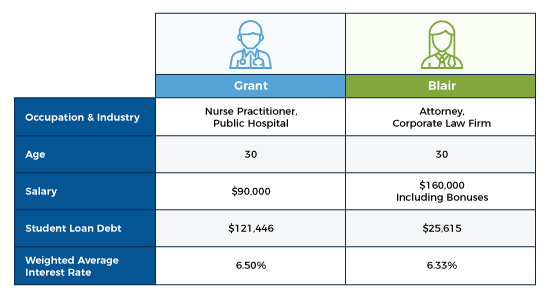
Given the nature of Blair’s corporate work and the ratio of her debt to income, it makes sense to evaluate a straightforward debt repayment strategy for her, balancing monthly loan payments with the total cost of repayment.
With Blair’s current income level, she’s a prime candidate for using a private student loan refinancing service, which could save several thousand dollars of interest by lowering her interest rate in exchange for only a very slight increase in monthly payments.
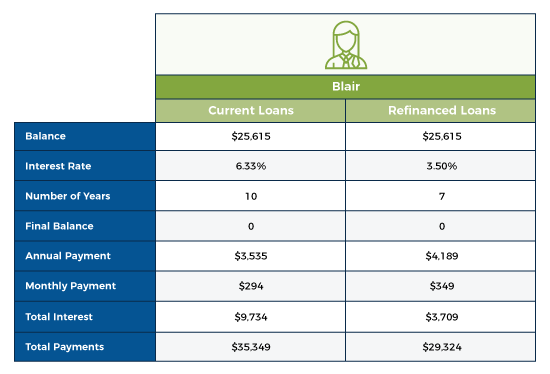 Through this private refinancing, Blair has to pay $349 – $294 = $55 more per month, but will have this debt repaid in 3 fewer years, paying roughly $6,000 less in total interest. Given her earning power, she’s likely to pay this off even faster, though as you’ll see, her high income is a key to the proposed strategy in this scenario.
Through this private refinancing, Blair has to pay $349 – $294 = $55 more per month, but will have this debt repaid in 3 fewer years, paying roughly $6,000 less in total interest. Given her earning power, she’s likely to pay this off even faster, though as you’ll see, her high income is a key to the proposed strategy in this scenario.
Turning to Grant, we see that he is the lower earner of the couple, and that he has more student loan debt than annual income. This, combined with his recent start of a job at a public hospital, makes him a prime candidate for PSLF.
How Public Service Loan Forgiveness (PSLF) Works
There are five main requirements to qualify for PSLF. While each of these requirements is relatively straightforward, they all have a bit more nuance than what might appear at first glance. And understanding these nuances is critical, as the majority of PSLF applicants are rejected simply because they have not met the stated requirements (as of June 2019, 100,835 PSLF applications were rejected, out of 110,729 applications – a rejection rate of 91%!).
Requirement #1: Work Full-Time For A PSLF-Qualifying Employer
The first requirement to qualify for PSLF is that the borrower must work full-time for a qualifying government or non-profit employer. More specifically, the PSLF Employment Certification Form indicates that a Qualifying Employer “includes the government, a not for-profit organization that is tax-exempt under Section 501(c)(3) of the Internal Revenue Code, or a private not-for-profit organization that provides certain public services. Serving in an AmeriCorps or Peace Corps position is also qualifying employment.”
To meet the “full-time” requirement, the PSLF applicant must meet one of the following requirements:
- If employed with only one qualifying job, the applicant must work at least 30 hours per week, or the number of hours the employer considers full time, whichever is greater; or
- If the applicant has more than one qualifying job at the same time (e.g., multiple part-time jobs), they must work an average of at least 30 hours per week.
In other words, PSLF applicants basically need to be working full time, as defined by their employer (as long as that’s at least 30 hours per week). If they are working part-time for more than one employer, then they would need to work at least 30 hours per week, on average, across all the qualifying employers.
Requirement #2: Make 120 “Qualified” Loan Payments
Monthly payments do not need to be consecutive, but you must make 120 of them, which works out to ten years of repayment. Which means that if a PSLF borrower switches jobs from a full-time position with a qualifying employer to a non-qualifying employer (or either stops working or does not meet the full-time employment requirement), and then switches jobs again back to a qualifying employer, the payments made while employed with the first qualifying employer (but not the second, non-qualifying employer) will still count toward the 120-payment requirement.
The timing of payments is important, also. While payments must be made on time, they should not be made too early, or they run the risk of not being counted toward the 120-payment requirement. For example, if a borrower begins making payments prior to working in a qualifying job, the payments made during that time would not count toward the 120-payment requirement. It could also be problematic if you pre-pay your debt (e.g., by making multiple payments in a month), as the extra payment would not be counted as a separate ‘monthly’ payment.
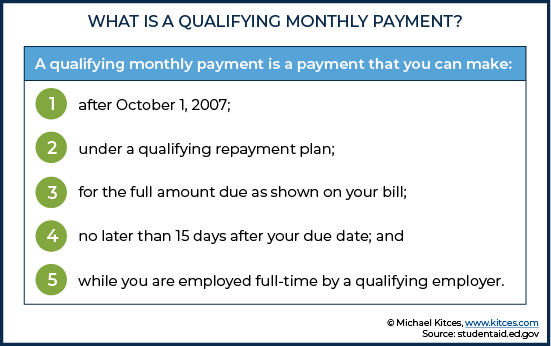
Requirement #3: Have The Right Types Of Student Loans
Not all Federal student loans are eligible for the PSLF program, so borrowers must be sure that their loans qualify.
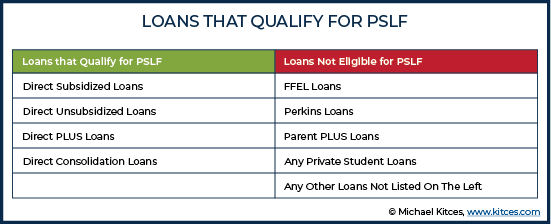
A common mistake that borrowers make is to begin payments on non-eligible loans, assuming that they will be counted towards PSLF. I’ve met with prospective clients who tell me “Yeah, I’m on track for PSLF.” only to have to break the news that the loans they have aren’t actually eligible, and that their payments unfortunately won’t be considered “qualified” for PSLF.
Requirement #4: Select A Qualifying Income-Driven Repayment Plan
All Federal income-driven repayment plans qualify for PSLF (the same Direct Federal loans that qualify for PSLF are also eligible for income-driven repayment plans). There are four of these repayment plans, and each bases the monthly payment on a percentage of the borrower’s discretionary income. This means that the payment amount is not linked to the loan balance and interest rate, which is both helpful for loan affordability itself… and, notably, also allows for planning opportunities beyond the traditional scope of debt repayment and refinancing (because borrowers can’t control the balance and interest rate once borrowed, but in many cases can control their income at least to some extent).
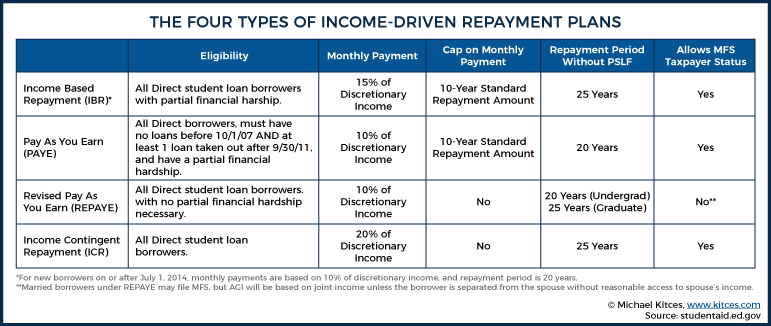
Keep in mind that PSLF is separate from the loan forgiveness feature inherent in income-driven repayment plans. For example, for borrowers who are not under PSLF and who complete the 20- or 25-year repayment period required by an income-driven plan (and assuming all plan requirements have been met), any remaining loan balances are forgiven as taxable income. By contrast, for an income-driven repayment plan that is under PSLF, the forgiveness period is reduced to ten years, and the amount forgiven is completely tax-free. In other words, even though PSLF always includes an income-driven repayment plan, being on an income-driven repayment plan does not necessarily mean you will qualify for PSLF. This is important to note, as many people enter income-driven repayment plans under the assumption they are on track for PSLF, when in reality they are not.
Though the standard 10 year repayment plan technically is eligible for PSLF, it's rarely the best plan given that in 10 years, the debt would be paid off entirely, thus negating the purpose of PSLF. Additionally, the graduated repayment plan, and extended repayment plans are also ineligible, though it’s possible a borrower on either of those plans could apply for Temporary Expanded Public Service Loan Forgiveness (TEPSLF), a ‘first-come, first serve’ offshoot program of PSLF, which according to the General Accounting Office (GAO), Congress funded with $700 million for borrowers who made the mistake of paying on plans ineligible for PSLF.
Requirement #5: Submit The Requisite PSLF Documentation
To enter the PSLF program, applicants need to file the PSLF Employment Certification Form. For first-time filers, this process will initiate a transfer of the current loans from any other servicer to FedLoan, the only loan servicer which works on PSLF. I suggest borrowers file this initial form as soon as they decide to embark on the path to PSLF, as getting qualifying payments transferred to FedLoan is one spot where the process can break down. In addition, a best practice is for borrowers to file this form annually to ensure that their payments are being counted toward the 120-payment requirement. Annual filing can also reduce the chance that a borrower will be asked to prove that loan payments were made in specific months several years ago.
After making all 120 payments, borrowers need to file the PSLF Application for Forgiveness Form. This triggers the review process to confirm that all program requirements have been met.
Because of the strict enforcement of these requirements and the high rejection rate of PSLF applicants, I recommend that advisors encourage their clients in (or applying to) PSLF to keep thorough records of pay stubs, monthly payments, and all communications with FedLoan.
Minimizing Required Loan Payments On The Path To PSLF
Since PSLF ultimately awards tax-free forgiveness of debt, financial advisors should help their clients in PSLF use strategies that allow them to pay the minimum possible amount to maximize forgiveness.
Returning to Grant’s situation, we’ll need to determine the best path to loan forgiveness based on his unique situation.
Because loan servicers won’t always have complete data on all of a borrower’s loans, any student loan analysis should always begin with a complete set of student loan data, which can be obtained from the National Student Loan Data System. This system provides a complete history of Federal student loans, whereas an individual loan servicer may have limited and incomplete information. While the information from the National Student Loan Data System will come in an unreadable .txt file, there are a variety of spreadsheets and software solutions which can translate the data into a useable format.
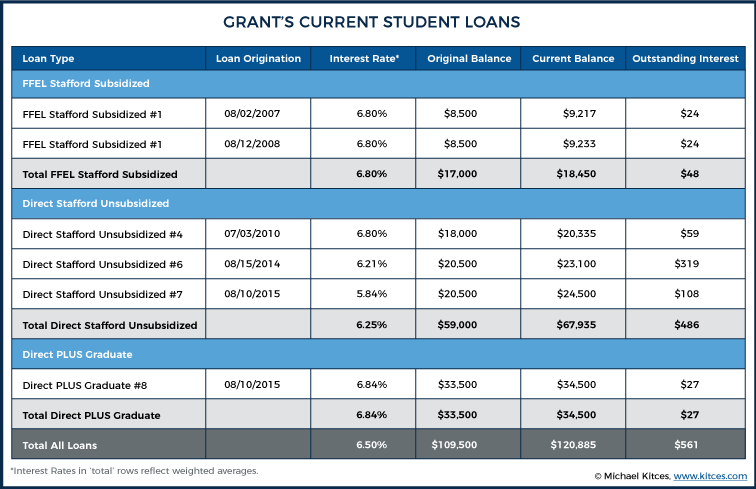
The first thing to notice is that Grant currently has two FFEL loans. Since FFEL loans do not qualify for PSLF, we’ll recommend that he consolidate the FFEL loans into a PSLF-eligible Direct Consolidation loan. He does not need to consolidate his other existing Direct loans, as they already do qualify, and since he can only consolidate most loans once, it wouldn’t make sense to consolidate his other Direct loans without a strong rationale. In addition, a consolidation means the outstanding interest will capitalize and he’ll pay interest on interest. Given the goal of PSLF, though, those consequences are worth the upside for Grant in this scenario, so we would recommend moving forward with a consolidation of at least the FFEL loans to get them eligible.
Reviewing Income-Driven Repayment Options
Once a complete list of all student loans is available, the next step is to determine which income-driven repayment option to choose. Each option uses a discretionary income calculation to determine the annual payment due.
Income Contingent Repayment (ICR) was the first Income-Driven Repayment plan, and since then, the plans have gotten progressively more generous to borrowers over time. Because ICR has higher repayment costs (i.e., 20% of discretionary income for ICR, versus 10 – 15% for other plans), it is never the best route for PSLF, thus we’ll leave it out.
Thus, the remaining options are:
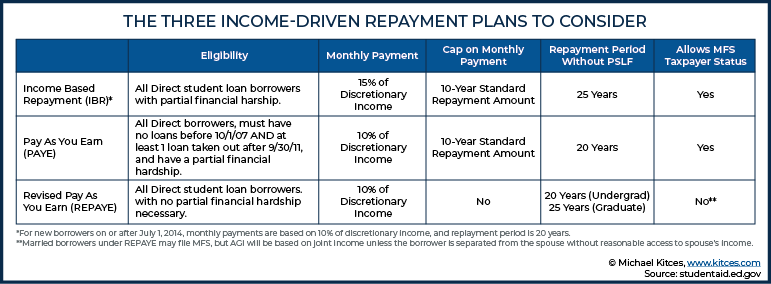
The potential for lower payments with the PAYE and REPAYE options is tempting for Grant; however, he is not eligible for PAYE due to having an outstanding Federal student loan balance prior to 10/1/2007.
REPAYE, then, would seem to be the best option to minimize monthly payments. However, there are two downsides to REPAYE. This plan does not have an income cap, so if Grant’s income grows rapidly, he could end up paying even more than he would on the 10-year standard plan. More critically in this scenario, REPAYE does not allow the use of Married Filing Separate (MFS) to determine the AGI for discretionary income. This means that monthly payments would be calculated based on 10% of Blair and Grant’s joint income.
If, instead, they use the IBR plan, they would be able to file their taxes as MFS taxpayers, and monthly loan payments would be based on Grant’s discretionary income alone. So even though the percentage of discretionary income is higher in the IBR monthly payment calculation (at 15% versus 10% of discretionary income), it will provide Grant and Blair with the lowest payment amount possible. And since IBR includes an income cap, monthly payments won’t skyrocket if Grant’s salary increases significantly over the years. For IBR repayment plans, there is a partial financial hardship if payments that would be made under a standard 10-year greater than the IBR payment calculated based on the borrower’s AGI and poverty line. Since Grant’s 10-year standard plan is much higher than his expected IBR payments (calculated below), Grant meets this requirement.
Minimizing AGI To Reduce Required Loan Payments
Given the goal of tax-free forgiveness, we are presented with a planning opportunity to drive down Grant’s AGI as much as possible, as the lower Grant’s income, the lower his IBR payments, and the higher the balance remaining to be forgiven at the end of the 10-year PSLF window. Additionally, the option to use a Married Filing Separate (MFS) filing status presents many opportunities to put Blair’s income to work strategically to reduce Grant’s AGI, since that will further improve cash flow for the household as a whole (as if Grant’s AGI is reduced, so are his IBR-determined monthly loan payments).
Healthcare coverage. If healthcare options at Grant and Blair’s employers are comparable, it makes sense to include their child on Grant’s insurance, thus reducing his W2 income. We could conceivably take this even further and have Blair enroll in Grant’s insurance plan, which may come with her own employer paying her some amount of money to make up for not covering her insurance costs. (There is also the side benefit of having the whole family on one plan with one deductible, one out of pocket limit, etc.) In Grant’s plan, this would increase healthcare premiums by about $500 per month. Assuming there are no options at Blair’s employer that are substantially cheaper (so it’s just a shift in cost), this reduces Grant’s AGI by $6,000/year.
Retirement Contributions. Given Blair’s larger income, Grant could look to maximize his 403(b) plan, and if available, a 457 plan as well. Blair should still save enough to get her matching funds, but the couple as a whole would benefit significantly from any dollars beyond what she gets matched to go towards maxing out Grant’s retirement accounts, rather than just contributing to each of their separate accounts from their separate salaries. AGI Reduction in 2019: $38,000.
Flexible Spending Accounts. If both spouses have access to flexible spending accounts they should use Grant’s to further reduce his AGI. There is a penalty here for use of the MFS filing status, reducing eligible expenses for dependent care from $5,000 to $2,500. Assuming they max out both the dependent care and healthcare accounts, this would reduce AGI by $5,200 in 2019.
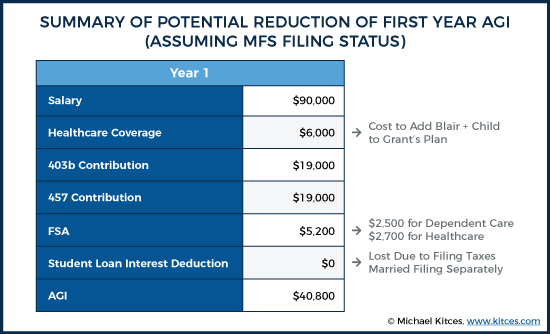
So, by contributing the maximum amount to Grant’s 403b and 457 plans, and by shifting deductions from Blair to Grant (by using Grant’s healthcare plan to cover his family and taking advantage of his FSA options), we have helped Grant reduce his AGI by over half, without reducing the couple’s total income, from $90,000 to $40,800!
We could go even further in looking for ways to reduce AGI, considering group term life, accidental health plans, cancer plans, pre-tax employee paid disability, etc. But, in this case, we’ll assume they skip those options and don’t utilize every last dollar of AGI reduction possible.
Calculating Loan Repayment Costs
To demonstrate the impact of planning to minimize monthly payments by reducing Grant’s AGI, let’s compare the required payment under the standard 10-year plan with the payment required under IBR:
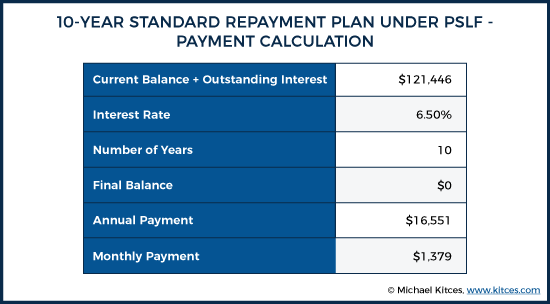
The required IBR payment is based on 15% of discretionary income (which is AGI minus 150% of the poverty line for your family size), is calculated as follows:

To calculate the poverty line for loan purposes, family size always includes your child and spouse, even if using Married Filing Separately. In 2019, the Federal poverty guideline for a 3-person household is $21,330. Calculating the IBR monthly payment is carried out as follows:
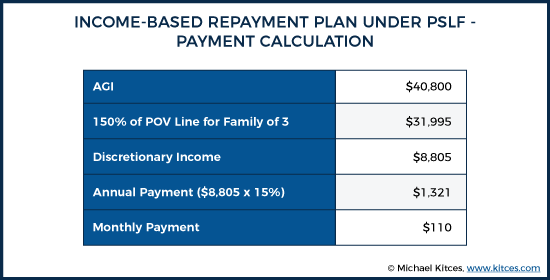
By maximizing every opportunity to reduce AGI, we’ve taken our required student loan payment from $1,379 per month under the standard 10-year repayment plan to $110 per month using the IBR plan. This works out to a first-year annual savings of $16,551 – $1,321 = $15,230! For which, again, the bulk of the unpaid student loan balance isn’t just deferred… but potentially permanently eliminated by qualifying for PSLF!
Quantifying the Economic Impact of PSLF on the Household
If we assume annual inflation is 2.5% across all the variables used to calculate AGI, we’ll see a very small uptick over time in the required payment for Grant to keep his loans in good standing, with a monthly payment in year 10 reaching approximately $140 per month.
The cumulative benefit of these strategies ends up at more than $150,000 of savings on Grant’s student loan payments, and including the $6,024 savings from refinancing Blair’s loans, our student loan planning helps this couple save a total of $156,737 over ten years!
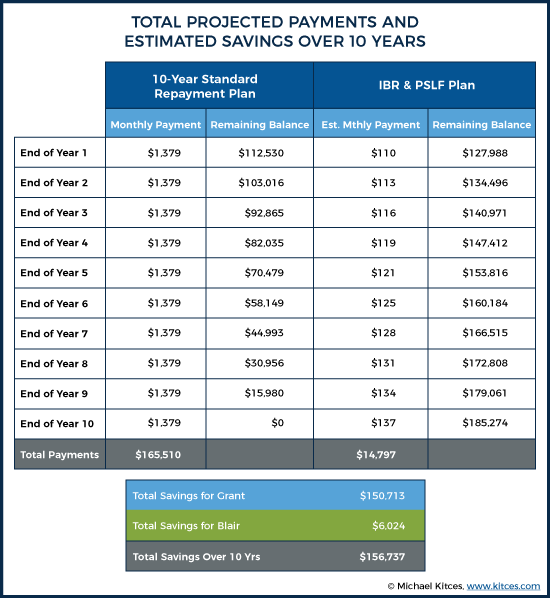
How The Benefits Compound
Not only have we helped our clients reduce their student debt obligation by more than $156,000, but this strategy lets Grant maximize annual contributions into his retirement accounts. While $38,000 of contributions is a large amount compared to Grant’s $90,000 income, it represents only 15% of combined gross income for the couple. Given our client’s high income to debt obligations, it should be relatively easy for them to fully maximize both of Grant’s retirement savings options, while also still setting aside money in Blair’s 401k, taxable savings, etc.
Looking at this another way, we took what would have been a $16,551 annual debt obligation (under the standard 10-year repayment plan), and transformed it into a $1,321 debt obligation in year 1 (under the IBR plan), while accomplishing a $38,000 pre-tax savings goal!
The new cashflow available for investment under the IBR plan, which would have otherwise been unavailable under the standard 10-year plan, amounts to $16,551 – $1,321 = $15,230 in year 1. Assuming even a 5% rate of return over the decade, this money is projected to grow to approximately $190,930 by year 10.
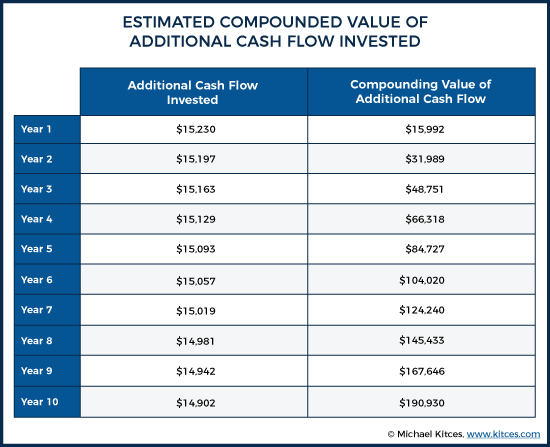
In addition to saving over $156,000 in debt payments, Grant and Blair have grown their savings to over $190,000 from funds that would have otherwise gone to paying Grant’s loans had they chosen the 10-year standard repayment plan. And, of course, that money will continue to compound for several more decades, given its location in Grant’s retirement plans.
Additional Variables That Could Increase Or Decrease The Value Of IBR And PSLF
It’s possible that the value of this planning could be increased, or decreased, depending on future events in the couple’s lives. If Grant’s income rises dramatically faster than the 2.5% per year we assumed, the benefits start to diminish, as with AGI increases, the required payment increases and thus the gap between the standard plan required payment and this plan narrows. In addition, IBR benefits would cease completely once Grant has an AGI higher than $141,500, as that level of AGI would require a payment as high as his payment on the 10-year standard repayment plan.
In addition, they may lose out on some other tax benefits by filing their tax returns as MFS versus MFJ, though those benefits would likely be small in comparison to the savings in loan payments. Of course, if Blair’s income as a corporate attorney climbs significantly faster than Grant’s, the costs of MFS filing would also grow. The couple would lose the ability to make Roth IRA contributions as well.
Alternatively, the benefits could be increased in a variety of ways. For example, if the couple has another child, their Federal poverty line amount would increase, which would decrease the total annual IBR loan payment required, allowing Grant to defer even more principal to eventually be forgiven under PSLF. Additionally, if the growth rate of healthcare costs, 403b/457 contribution limits, or FSA allowances outpace income growth, there would be new, potential opportunities to save even more.
Downsides Of Planning To Minimize AGI To Maximize PSLF
While there is tremendous value in planning for PSLF, strategies to minimize loan payments do not come without risks. Negative amortization (where payments are less than the annual interest obligation, which in turn adds to the subsequent year’s principal, causing the loan balance to rise over time despite ongoing payments) is one of several potential downsides to this plan. In this scenario, the student loan payment will be much less than the interest that accrues each year, and so the loan will grow over time. In Grant and Blair’s scenario, the estimated loan balance at forgiveness will have risen from $121,446 to $185,274. This can negatively impact Grant’s credit score, though, with the earning potential of this couple and responsible credit usage, the effect on their credit isn’t expected to be a major hindrance. Especially since it ultimately results in most of that debt principal being forgiven under PSLF anyway!
And while the concept of PSLF can look really great on a spreadsheet, watching that loan balance grow over time, even as payments are made each month, can become a difficult psychological burden.
The biggest risk faced by Grant would be if he were to switch jobs and no longer work for a PSLF-qualifying employer. At that point, not only would he need to increase his loan payments to begin paying down his debt, the amount he would need to pay would actually be more than if he had initially started paying the debt down in year 1 of the loan (again due to the negative amortization).
For example, if he decides after three years to work at a private, for-profit hospital, his loan balance would have negatively amortized from the original balance of $121,446 to $140,971, which means he would need to pay down almost $20,000 more in debt than he had at the beginning of entering the IBR program! In essence, this means that once the path to PSLF is chosen, it can limit a borrower’s job options until the program is completed. Which means that a plan to pursue PSLF is not something to enter into lightly.
The other risk to consider is the program itself. There has been a lot of media attention about the problems with PSLF, highlighting significant issues from lost paperwork to borrowers having to fight to get their payments properly counted. It’s flawed, and more than likely will require applicants to be incredibly vigilant to get their loans forgiven. But given the high stakes (and appealing payoff) for many borrowers, those headaches are often well worth the risk.
In fact, it’s unfortunate that recent media coverage has been so negative, some potentially eligible PSLF borrowers may be unnecessarily eschewing the program. An often-cited statistic is that more than 99% of applicants for PSLF have been rejected. However, this 99% rejection rate is in large part due to applicants who didn’t actually meet the criteria. Still, others were rejected because of small administrative errors, such as applying for forgiveness before having certified all the payments. Finally, because Federal Direct loans did not become predominant until 2010, most borrowers who took out loans before then don’t have the correct loan type to be in the program and would have needed to complete a consolidation to become eligible (but in fact could become eligible once they do so). Even the Temporary PSLF (TEPSLF) program, implemented to assist PSLF applicants who were rejected because they were disqualified from PSLF, has a 99% denial rate, as of May 2019, according to the Government Accounting Office, but again mostly because applicants did not meet the requirements to qualify. Even so, despite the unfortunate reality that the process is admittedly painful and needlessly complex, we are starting to see the success rate tick upwards. I am inclined to think we’ll only see that continue as more and more applicants become eligible for the program, and figure out how to navigate the process of filing for and claiming PSLF.
There is political risk as well, though I believe that to be quite small. In the 2015 proposed budget, the Obama administration proposed capping loan forgiveness at $57,500, and in the 2020 proposed budget released earlier this year, the Trump Administration proposed eliminating the program altogether. However, both of these proposals would only impact new borrowers, and would grandfather borrowers already in the program. Accordingly, since PSLF is written into the promissory notes of Federal student loan borrowers to date, if an administration were to decide to terminate the program for existing borrowers, there would likely be an immediate lawsuit given the number of potential plaintiffs in such a case.
Coming back to our client, assuming that Grant stays in his job at the public hospital (or switches to another qualifying public service employer), maintains a full-time schedule, continues to make timely loan payments, and stays up to date with all of the ongoing paperwork, it’s highly likely that Grant will save himself hundreds of thousands of dollars by pursuing this path.
Student loan repayment is an area many financial advisors have not previously spent much time advising on, as traditional models for financial planning generally involve people who seek an advisor after they have paid off their debts and have accumulated assets. Given the rising student debt levels for this generation, advisors are highly likely to see more and more clients coming to them with student loan repayment questions.
Generally, advisory firms have three options in this area:
- Build this knowledge in house by having a team member specialize in the area – the Certified Student Loan Professional designation is a great starting point for advisors to learn the ins and outs of student loan advising;
- Identify when a scenario is beyond their knowledge level and hire an expert to consult; or
- Refer the prospect out to another advisor who does have this expertise.
As shown in our case study, the variables and complexities with student loan repayment are significant, and an advisor can have a tremendous impact on a client if they are able to effectively advise on large student loan levels. A client you help to save more than $150,000 is likely going to be a client for life! Conversely, an advisor who is not attuned to navigating student loan repayment could cost a client tens of thousands of dollars by recommending only the traditional debt management pathways.
Ryan would like to give a special thanks to Jantz Hoffman and Heather Jarvis for their contributions to this article. You can learn more about the Certified Student Loan Professional program by visiting cslainstitute.org.




